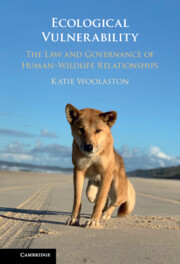
-
Select format
-
- Publisher:
- Cambridge University Press
- Publication date:
- June 2022
- June 2022
- ISBN:
- 9781009051958
- 9781316511992
- Dimensions:
- (229 x 152 mm)
- Weight & Pages:
- 0.5kg, 248 Pages
- Dimensions:
- Weight & Pages:
You may already have access via personal or institutional login
Book description
Humans are responsible for biodiversity loss in many related and sometimes conflicting ways. Human-wildlife conflict, commonly defined as any negative interaction between people and wildlife, is a primary contributor to wildlife extinction and a manifestation of the destructive relationship that people have with wildlife. The author presents this 'wicked' problem in a social and legal context and demonstrates that legal institutions structurally deny human-wildlife conflict, while exacerbating conflict, promoting values consistent with individual autonomy, and ignoring the interconnected vulnerabilities shared by human and non-human species alike. It is the use of international and state law that sheds light on existing conflicts, including dingo conflict on K'Gari-Fraser Island in Australia, elephant conflict in Northern Botswana, and the global wildlife trade contributing to COVID-19. This book presents a critical analysis of human-wildlife conflict and its governance, to guide lawyers, scientists and conservations alike in the transformation of the management of human-wildlife conflict.
Reviews
‘… an ideal reference for environmental lawyers, conservation researchers ... (especially students), practitioners, and policy makers looking to delve deeper into the nuances of environmental jurisprudence vis-à-vis human-wildlife conflict. … It is an important and valuable addition to the vast literature on the subject and is novel insofar as it attempts to understand human-nature relationships in their entirety and the interactions between the psycho-social, cultural, economic, and political factors, aside from the ecological ones.’
Saloni Bhatia Source: Conservation and Society
Contents
Metrics
Full text views
Full text views help Loading metrics...
Loading metrics...
* Views captured on Cambridge Core between #date#. This data will be updated every 24 hours.
Usage data cannot currently be displayed.
Accessibility standard: Unknown
Why this information is here
This section outlines the accessibility features of this content - including support for screen readers, full keyboard navigation and high-contrast display options. This may not be relevant for you.
Accessibility Information
Accessibility compliance for the PDF of this book is currently unknown and may be updated in the future.


